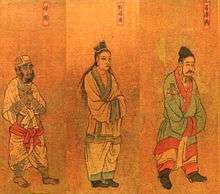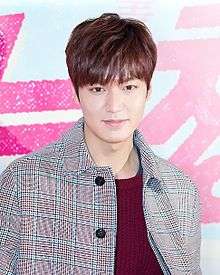Kkonminam
Kkonminam (Korean: 꽃미남; Hanja: 꽃美男; ![]()
History

The Hwarang, or "flower youths" or "flowering knights/gentlemen", were an elite group of male warriors in Silla, an ancient Korean kingdom. Chinese sources referred only to the physical beauty of the "flower boys" who were known for their use of make-up, cosmetic decorations and accessories.[3] The emergence of kkonminam was a socio-cultural phenomenon associated with the influence of Japanese bishōnen or yaoi manga that became available after the ban on the import of Japanese culture was lifted in Korea in 1998.[4] Professor Kim Hyun Mee at Yonsei University attributes this to the growing independence and confidence of Asian women: "[they] can afford to be more selective when choosing a mate."[5]
The National Security Act affected South Korea in the 1990s when restrictions were placed on international imports. Due to the Act, Korea experienced restrictions on television programming. Television companies turned instead to establishing channels such as Mnet in order to broadcast commercial programs such as K-pop. Mnet is a South Korean television music channel that has a variety of talk, game, and live music shows.[6]
In the late 1990s, Kkonminam images became notable in the Korean entertainment industry, glorifying "pretty" boys with smooth, fair skin, silky hair, and a feminine manner. These new images replaced the previous ones of tough and aggressive Korean men in television commercials, dramas, and on billboards.[4] The Kkonminam phenomenon is prominent in Korean popular culture; it can be seen in fashion, music, photography, advertising, and television.[7]
Television

In 2009, a Korean television series called Boys over Flowers (based on Japanese shojo manga Hana Yori Dango) gained popularity in South Korea and across Asia. The plot follows an average high school girl who gets involved in the life of an arrogant rich boy and his friends. In Boys over Flowers: "the males have childlike and boyish features in contrast to their strong and muscular bodies. The popularity of the show influenced many South Korean men to take their appearance more seriously. An increasing number of South Korean males began applying cosmetics, wearing preppy and cruise-like outfits and sporting traditionally feminine looks, colors, and prints".[8]
Korean boy pop bands
Crystal S. Anderson, a Cultural Studies research scholar at Longwood University, found a variety of ways in which global fans refer to the unique masculinity of male K-pop groups. One respondent wrote: “I am also really curious about flower boys and the varying expressions of masculinity in Korean boy bands.” Another respondent noted: “The first thing that attracted me when I was young is that Korean artists were exceptionally handsome/beautiful and possessed unique style, both in their music and fashion,” linking appearance to a certain style.[9]
Hybrid bands
Examples of Korean boy bands that exemplify this phenomenon are 2PM, Highlight, and MBLAQ.[7][10] These bands draw on elements of "gangster" and hip-hop themes in their performances. The hybridized aspects help the bands appeal to broader audiences. Analysts note that these boy bands display masculinity of both kawaii and kkonminam elements.[10] These boy bands test stereotypical masculinity.
Due to their tough masculine image, 2PM have been nicknamed by local Korean media and netizens as Jimseungdol.[11] On-stage, they showcase theatrical manliness. In performances of Heartbeat, the title song of their first album, they put on a hyper-masculine, beast-like performance. In the performances, Taecyeon tears off his shirt, Nichkhun symbolically rips out Taecyeon's heart in a brutal manner, and Chan-Sung breathes fiercely while lifting Nichkhun over his head.[7]
References
- Elfving-Hwang, Joanna (2011). 'Not So Soft After All: Kkonminam Masculinities in Contemporary South Korean Popular Culture' Conference Proceedings of the KSAA 7th Biennial Conference, Paper no. P049. p. 2–21. ISBN 978-0-7334-3079-4. Retrieved 22 March 2019.
- Rutt, Richard, The Flower Boys of Silla (Hwarang). 1961.
- Sun, Jung (2010). "CHOGUKJEOK PAN-EAST ASIAN SOFT MASCULINITY". In Daniel Black, Stephen Epstein and Alison Tokita (ed.). Complicated Currents: Media Flows, Soft Power and East Asia. Monash University ePress. Retrieved 15 December 2012.
- "Mirror, Mirror..." Time. 24 October 2005. Archived from the original on 15 December 2005.
- Taylor, Constance (2007). Kkonminam: An Exploration of Representations of Masculine Identities in the K-pop Industry (Thesis). University for the Creative Arts. Retrieved 23 October 2018.
- Leung, Sarah (2012). Catching the K-Pop Wave: Globality in the Production, Distribution, and Consumption of South Korean Popular Music (Thesis). Vassar College. Retrieved 23 October 2018.
- Lee Hyo-won (12 February 2009). "Men, Be Beautiful for Spring, Summer". The Korea Times. Retrieved 24 October 2018.
- Anderson, Crystal S. (2014). "That's My Man! Overlapping Masculinities in Korean Popular Music". In Kuwahara, Yasue (ed.). The Korean wave : Korean popular culture in global context. Palgrave Macmillan, New York. pp. 117–131. doi:10.1057/9781137350282_7. ISBN 978-1-349-46832-4.
- Kim, Soyoung. "Men in K-Pop: From "Flower Boys" to "Beast-dols" | Arts | The Harvard Crimson". www.thecrimson.com. Retrieved 24 October 2018.
- Jung, Sun (2011). Korean masculinities and transcultural consumption: Yonsama, Rain, Oldboy, K-Pop idols. Hong Kong University Press. ISBN 978-988-8053-63-6. JSTOR j.ctt1xcrmm.